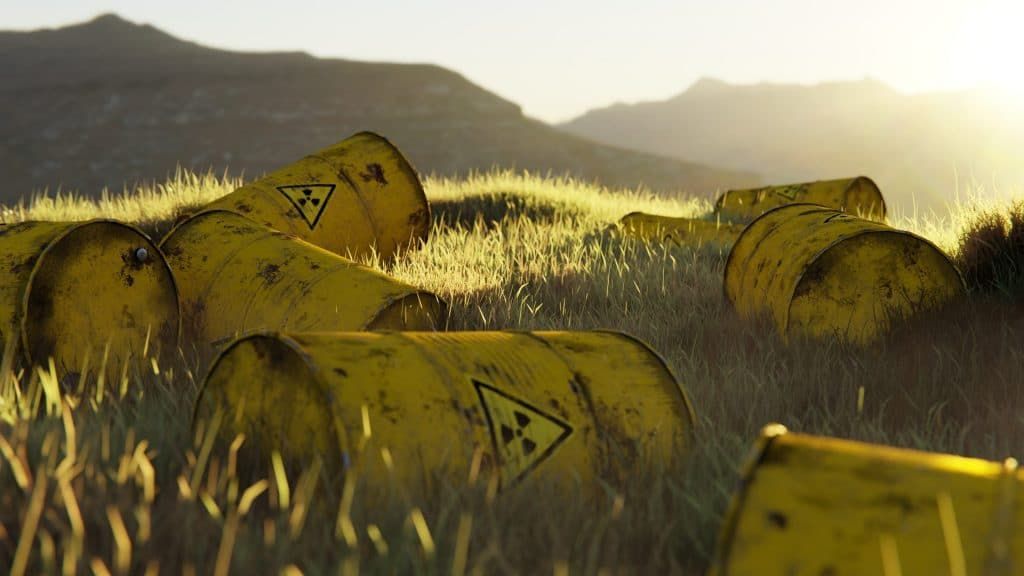A better way to store nuclear waste: Ask for consent.
By Seth P. Tuler, Thomas Webler | April 21, 2021
 Radioactive waste barrels. Credit: Recognize Productions from Pexels. Public domain.
Radioactive waste barrels. Credit: Recognize Productions from Pexels. Public domain.
Almost a decade has passed since the Blue Ribbon Commission on America’s Nuclear Future recommended a new management approach for the country’s growing inventory of commercial spent nuclear fuel and high-level radioactive waste. The commission reported that the United States’ failure to develop a safe and timely program for managing these wastes resulted from a top-down approach that never achieved technical consensus or social acceptance. To forge a more successful path, the commission called for a consent-based approach in which communities with adequate knowledge of risks, benefits, and technical requirements could volunteer to host one or more geological repositories and interim storage facilities. The Energy Department made some preliminary progress on defining what such a process might look like during the Obama administration, but that initiative was soon squelched by the Trump administration.
The Biden administration should restart an inclusive process to design a consent-based siting approach for spent nuclear fuel and high-level waste disposal. Fast action is needed because private corporations are offering to “solve” the problem—temporarily in the case of interim storage proposals in Texas and New Mexico and permanently in the case of companies proposing the use of innovative, but unproven, technologies. Legislative proposals have also emphasized quick and piecemeal solutions (e.g., S.1234, HR.2699) that reduce consent to agreement by elected state and host community officials. Together, these efforts are likely to exacerbate challenges to developing a socially acceptable, cohesive, and effective strategy for managing spent nuclear fuel and high-level radioactive waste. They undermine conditions necessary for consent in a holistic systems-oriented solution.
What does consent involve? Many countries, including Canada, Sweden, Finland, Germany, Japan, and the United Kingdom, have embraced the concept of consent for locating spent nuclear fuel and high-level waste storage and disposal facilities. The United States government has not, despite strong support since the 1990s from close observers of nuclear waste management. In 2016, the Energy Department held a series of public meetings to gather input about what a consent-based process might look like. This was a wise way to begin, although they did not build on theories of consent or identify previous lessons learned.
Scholars and policy makers from medicine, research ethics, development projects in indigenous communities, and democratic theory have defined principles and practices for “voluntary informed consent.” Those being asked to consent should do so without coercion or manipulation, have the power to say “no,” and adequately understand the risks and benefits. Consent seekers must share relevant information in a way that is comprehensible, promotes understanding of risks and benefits, and informs individuals’ decisions. Finally, consent seekers should acquire consent prior to making a decision or taking action.
Consent in the context of medical treatment and research ethics relates to individuals, and these fields have helped inform the idea of community consent. For example, free, prior, informed consent—a notion that has been promoted by the United Nations in the context of large-scale development projects in indigenous communities, including dams, ports, and mines—is based on the fundamental concepts of autonomy, self-determination, and understanding that are found in medical and research ethics and human rights. A community should decide for itself whether to accept the risks and benefits associated with new infrastructure. It should also be able to negotiate packages of benefits to offset risks associated with the project and leave the community better off. At the same time, compensation packages should not be coercive. The exact nature of free, prior, informed consent will depend on local procedures and institutions, customary law and practice, and international guidelines and principles that establish minimum standards.
Recommendations for a consent-based approach to siting of spent nuclear fuel and high-level waste facilities. The United States faces at least seven significant challenges in designing and implementing a consent-based process. We offer the following recommendations inspired by theories and practice of informed consent.
Build trust that promises will be kept. The history of nuclear waste management is littered with broken promises and inconsistent policies and laws. Public trust and confidence in the institutions responsible for managing nuclear waste are weak. Policy swings accompanying changes in administrations and Congress exacerbate distrust. The promises of the Nuclear Waste Policy Act of 1982 survived a mere five years before Congress reneged on its own principles. The Energy Department’s recent efforts to change clean-up compliance agreements for federal nuclear weapons facilities underscores feelings of distrust that some members of the public, interest groups, and state and local officials hold for federal authorities. Members of the public have also questioned the motives of private corporations, given the corporations’ fiduciary pressures, desire to protect proprietary technologies, and need for stockholder accountability. When parties to a process lack confidence that commitments will be kept, those parties are prone to misunderstandings, have trouble problem-solving collaboratively, and forge unstable agreements. Building trust takes time, consistency, and transparency.
Ensure the process is informed by the best scientific understandings. As the Blue Ribbon Commission made crystal clear, a safety case should be mandatory before approval for a repository is given. Designers of a consent-based process should ensure that the best available science informs decision making and that conclusions are technically competent. This can help repair low levels of public trust in the institutions involved. A consent-based process should not allow “alternative facts.”
The Nuclear Waste Policy Act Amendments of 1987 established a Nuclear Waste Technical Review Board to provide technical advice about site characterization, packaging, and transport issues. However, Congress left out a formal way to ensure that the best available science on other issues, such as planning and decision-making processes, would be included. Given the many challenges and risks, the board should include a broader range of social science expertise about economics, ethics, insurance, compensation, policy, law, risk perceptions, risk communication, and public and stakeholder participation. The board should also include participants with local, grounded knowledge relevant to understanding the contexts of potential host communities.
Many types of expertise are needed to ensure that claims integral to the process are vetted.
Determine who consents for whom. Proposals for siting processes often recommend that multiple stakeholders—governments, interest groups, private business, and the general public—get involved. But who should have the power to issue or withhold consent? As we have written before in the Bulletin, the failure of past government efforts can be traced, in part, to poor stakeholder and public engagement. The governing political body has some legitimacy to speak on behalf of the public, but how far does this legitimacy extend? Do elected local, tribal, or state officials have a mandate to make single-issue decisions with severe and lasting consequences for a community’s identity and cohesiveness? There should be a role for other interested and affected parties and many ways to make collective decisions (citizen juries, expert and citizen advisory committees, referendums, for example) have been formulated. But there is no clear answer to who should participate in such processes.
Furthermore, future nuclear waste facilities will be located in a nested hierarchy of political jurisdictions, including counties, tribes, and states. This is not an abstract concern; New Mexico legislators and the Texas governor have opposed interim storage facilities proposed in their states. Tribal sovereignty is particularly relevant in this context, as they have special rights not afforded to states and municipalities. Each of these jurisdictions might need to make consent decisions in their own way. How do all those decisions add up to a single expression of consent or rejection?
Ensure full and timely disclosure of information. For a science-led, transparent, consent-based siting process, information is key. But how much is needed, and when and how should it be disclosed? When private organizations are involved, governmental bodies may not be able to ensure full disclosure of information relevant to understanding risks and benefits. Failure to disclose information at all or in a timely manner can lead to poor decision making and exacerbate social distrust. At the same time, disclosing information during a process can have its own drawbacks. For example, initial studies may contain inaccuracies and uncertainties that, when amended later may undermine public confidence and trust in the organizations and regulatory agencies.
Ensure adequate understanding among those whose consent is being sought. What information is needed to ensure informed choices? Consent-givers need not achieve understanding on par with experts. “Adequate” understanding means that the consent-giver knows enough such that the actual outcomes and consequences of their decision to issue or refuse consent are reasonably consistent with their expectations. This implies that interested and affected parties should help determine what information is needed to address their concerns about risks and benefits.
Ensure that consent or rejection is truly voluntary. Sometimes developers of hazardous facilities have included negotiations about benefits for the host community, a move that has been encouraged in the context of nuclear waste siting efforts. When do benefits become perceived as bribes?
Benefits can be unduly coercive under some conditions and therein undermine claims that agreement is truly voluntary. Some may feel coercion is present while others may disagree. “Situational coercion” results when a community is in such a desperate state that any offer with benefits is irresistible even if the offer would normally be considered unwelcome. This can result in unwanted facilities being placed in poorer and minority-majority communities. Then again, communities that have historically carried a disproportional burden of risk may negotiate a package that remedies past inequities. In either case, negotiations can end up looking like a bribe and exacerbate conflict when some individuals and groups are seen as winners and others as losers.
Determine how and when consent is expressed. Important decisions such as hosting a nuclear waste facility should be made using a process that is widely understood and perceived to be fair and legitimate. Guidelines for how choice is determined (e.g., majority vote) and sanctions or penalties levied for violations of procedural rules should be negotiated and clearly defined before a process begins.
When procedural rules are imposed by outsiders, local people may see the imposition as undermining their autonomy. Similarly, when local authorities determine procedural rules, they may marginalize parts of their community or abutting communities in the planning process. Minimal standards should be developed in advance of processes being initiated. Furthermore, mechanisms adopted by local governments to express consent may only indirectly bear on the decision at hand.
For example, in Texas, the company seeking to develop an interim storage facility argued that consent was obtained from the local community by a narrow majority vote on a bond issue—not on an explicit question of whether there should be a radioactive waste disposal facility in the county. Some countries, such as Canada and the United Kingdom, use a multistep approach to achieve informed consent from potential host communities and even allow communities to withdraw from a process up to a certain point, such as when a license is granted or construction begins.
A systems-oriented approach is needed. There is widespread international consensus that the best permanent solution to the problem of spent nuclear fuel and high-level radioactive waste disposal is to store it in deep geological repositories. Identifying US sites for one or more repositories is essential but not the only challenge. An American consent-based process for siting infrastructure must consider the full range of interconnected components needed for a waste management system. This system comprises the technologies that produce and isolate spent nuclear fuel and radioactive wastes, geologic systems to isolate radiation, transportation infrastructure and systems for loading casks and moving wastes from their point of generation to storage and disposal sites, and the institutional, legal, regulatory, and policy systems that define responsibilities and limitations of private and public entities.
Will the United States adopt a consent-based siting process for waste disposal? The Energy Department and independent groups and scholars have contributed meaningful ideas about consent-based approaches, including the value of building trust and confidence in a process, empowering potential host communities, and ensuring transparency. However, they have yet to grapple with key details required to design and implement an effective consent process.
The Energy Department (or a new organization responsible for a nuclear waste program, as proposed by the Blue Ribbon Commission and others) should restart a national process to design a broadly supported, socially and ethically legitimate, consent-based siting process for spent nuclear fuel and high-level radioactive waste. This will take time.
While maintaining a focus on efficiency to resolve this urgent problem, a consent-based approach offers a way to overcome the stalemate that has defined the US program for decades. The time it takes to develop a safe, legitimate, and fair solution will be well-spent, especially given that Congress and private industries are now proposing interim and permanent solutions whose implications for crafting a comprehensive solution are unclear. With the Biden administration’s emphasis on social and environmental justice, will the United States commit to a democratic solution for siting spent nuclear fuel and high-level waste disposal?
We dedicate this article to Dr. Roger E. Kasperson (1938-2021), our mentor and colleague, who warned us that working on nuclear waste management issues would last a lifetime and inspired us to advocate for solutions grounded in inclusive, equitable, and science-based processes.
Together, we make the world safer.
The Bulletin elevates expert voices above the noise. But as an independent nonprofit organization, our operations depend on the support of readers like you. Help us continue to deliver quality journalism that holds leaders accountable. Your support of our work at any level is important. In return, we promise our coverage will be understandable, influential, vigilant, solution-oriented, and fair-minded. Together we can make a difference.
Keywords: nuclear waste, radioactive waste, siting, spent nuclear fuel
Topics: Nuclear Risk, Nuclear Weapons

















This piece is an important contribution to the dialogue on nuclear waste management and policy. But I think it is still putting the cart before the horse, by jumping to the ostensible “end” of the nuclear waste storage process (i.e., siting a permanent repository or consolidated “interim” storage facility). The communities where waste is currently stored are not adequately protected, and will remain so for decades regardless of what path to long-term management is pursued. If the government (and industry) do not protect the communities that currently store the waste, then why should the public trust that communities that would… Read more »
Deliberate abnegation of the considerable work of Native Americans and interested citizens.
The article in question says:“Minimal standards should be developed in advance of processes being initiated”. But the time has been spent and the work already done.
For minimum standards see the Anishinabek/Iroquois standards for spent fuel storage — ask [email protected] and I’ll send them to you. For Environmental Justice information see the Jemez Principles https://www.ejnet.org/ej/jemez.pdf, and the 1991 EJ Principles https://www.ejnet.org/ej/principles.pdf.
This work has already been done. Some of the most competent and interested parties to this problem have been offering solutions for years
HOSS is a “Systems-Oriented” approach There is a widespread international consensus that the best permanent solution to the problem of spent nuclear fuel and HLRW is Hardened On-Site Storage (HOSS). It is based on an ethic saying the communities that benefitted from the power should be responsible for the waste and not send it to New Mexico which has ZERO nuclear power plants. In addition, you don’t mention a major requirement for any system purporting to deal with the issues surrounding spent nuclear fuel, namely the need for a “hot cell”: a facility at each site to repair degraded casks and… Read more »
Nuclear waste. Two loaded words. Informed consent are two others. Trust the agencies. Humanity is and has always been short sighted and focused on near term benefit. We forget to our peril that there are no long term solutions to nuclear waste storage. None. Who among us can say what the future brings? That something that is deadly for thousands of years can safely be squirreled away in some underground cavern for longer than civilization has existed? There can be no informed consent about this. As pleasant and accomodating as it sounds. However much any potential reward or presently helpful… Read more »
Thank you Mr. Searle. You have a firm grasp of the problem. I attended 4 out of 8 of the “Consent-based” siting meetings held by the DOE. The last was in Minneapolis-StPaul. Karen Hadden (TX) got up and said: “You quit making high-level nuclear waste, THEN come to us and ask what to do with it”; and a skit “Nuclear Waste and Ham” — a send up of you-know-what — was presented as an interruption to the proceedings. I have several versions of that skit if you are interested. I would like to stay in touch because you are so… Read more »
This is something that holds my interest. We are sold the potential benefits of nuclear energy, and there are many who see it as a climate saving replacement for fossil fuel. It isn’t. And that doesn’t come close to dealing with legacy products associated with weapons production.
Is there a reason you show the jumbled, rusted low-level waste drums when you are discussing used nuclear fuel? It gives the public the impression that that is how we handle used fuel.
Hello Roger Blomquist. I went through all these comments again, but can’t find what you are referring to. I know there are inaccurate (to say the least) images like the one you described that are sometimes the lead off to very informative articles. If I used such images, I will be more careful to avoid them in the future. I really appreciate you correcting my work, but I can’t locate what you are saying in this particular trace.